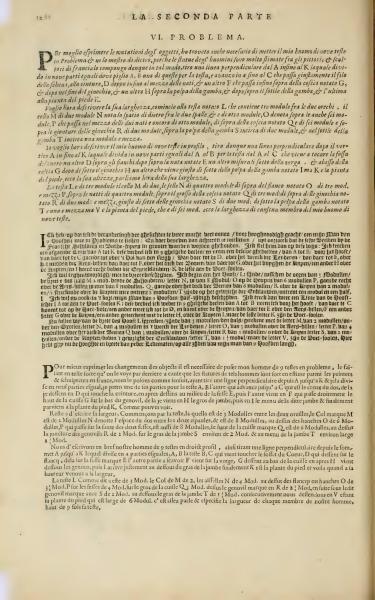THE SECOND PART
VI. PROBLEM.
To better express the changes in objects, I also found it necessary to place my nine-headed man in a problem, showing it from behind because the structure of such men is highly valued among painters and sculptors in France. Thus, it is composed in such a way, with a perpendicular line from A to K, divided into nine equal parts, starting from A for the head and continuing to C, which crosses the spine at the waist. From there, another C line goes above where another line intersects at the knee, and another H touches the patella, finally reaching the foot at K.
Regarding the width, begin at the head marked L, which consists of three modules between the ears, the neck (M) of two modules. N denotes the space at the back between the shoulders, a module; O indicates above the hips, labeled at Q, above at the middle of the thighs two modules, measures six modules, and narrow at the knee junction R of two modules. This continues above the calf at S, ending in two modules at the ankle, with the foot covered to span another module of width.
The profile view of my nine-headed man requires a perpendicular line from the vertex. Thus, I use a line that runs from A to B for the head, C for the curvature above and course of the thigh, where another joins at H on the knee halfway, and stretches to the foot, where width is also shown.
The range with four modules; shoulder blade marked by two modules above N four modules, hip at O three modules, knee marked R at two modules; and begins calf width marked S in three modules, reaching the foot's width in six modules. This reflects the breadth of each part of a man of nine heads.
In a similar vein in Dutch, illustrating the extent where the body's specific dimensions translated to graphical proportions, outlining the visual explanations as derived.
To better express object changes, it is necessary to portray my nine-headed man in question, displayed from behind to emphasize features prized among French painters and sculptors. Divided into nine equal sections, with different parts assigned specific measurements according to artistic standards.
To detail the width, start with the head, which measures three modules between ears, the neck two modules, and spacing behind the shoulders fills another module. Additional body sections measured accordingly reflecting these artistic proportions, ensuring cohesion among elements.
Expressing a person of nine heads requires linear proportions from main points indicated at intervals set for visualization purposes, balancing proportions carefully to ensure the correct presentation of parts. Final widths marked explicitly for precision in construction.
The text discusses the method of representing a human figure with nine heads, a concept used to describe proportions in art. It outlines the process of scaling the human body using a perpendicular line divided into nine equal parts, covering both width and height measurements. The instructions guide how to proportionally adjust body parts such as the head, neck, shoulders, hips, knees, and feet, ensuring accurate artistic representation.
